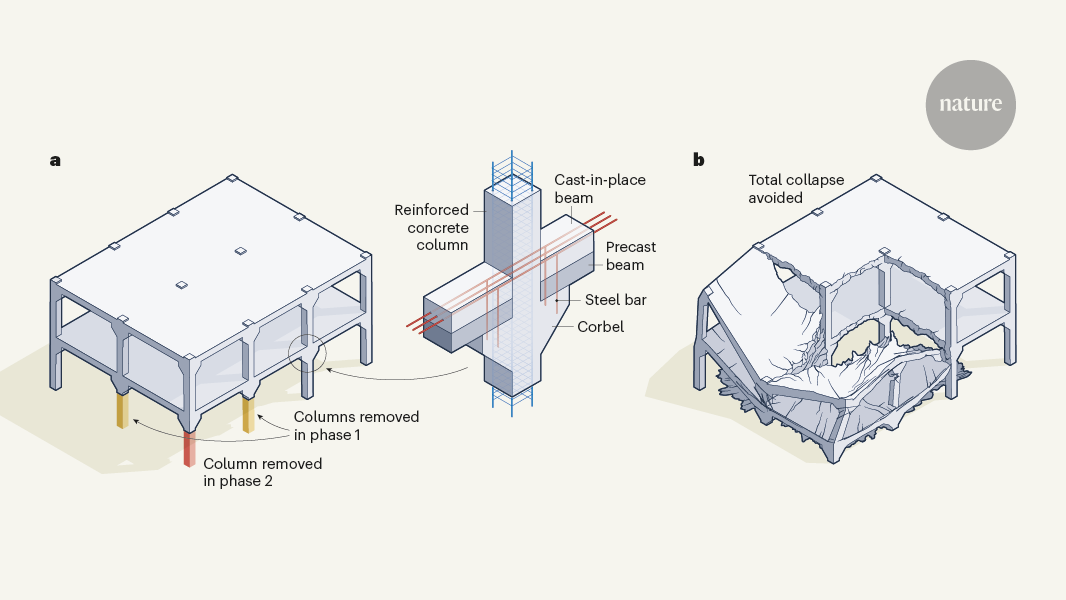Preventing Catastrophic Building Collapses: Strategic Connections as a Safeguard
Core Concepts
Strategic connections can control the progression of building collapse, making structures more resilient and preventing total failure.
Abstract
The article discusses the problem of building collapses, where a localized failure can sometimes trigger the progressive collapse of an entire structure or a large section of it. The author introduces a potential solution - the use of strategic links or connections that can prevent the "domino effect" and control the progression of collapse.
The article starts by describing the sudden collapse of the Champlain Towers South residential building in Florida in 2021, which occurred within seconds after the pool deck gave way. While such extreme failures are rare, building collapses do still happen, often due to severe weather, accidents, deterioration, or construction/design errors.
The author then presents the work of Makoond et al., who have reported an addition to an engineer's toolkit that can make buildings safer and more resilient by controlling the progression of collapse. The key idea is to incorporate strategic links or connections within the building's structure that can prevent the domino effect and localize the damage, rather than allowing it to spread throughout the entire structure.
The article suggests that this approach could be a valuable tool for engineers to improve the safety and resilience of buildings, potentially preventing catastrophic failures like the one seen in the Champlain Towers South incident.
Strategic links save buildings from total collapse
Stats
None.
Quotes
None.
Key Insights Distilled From
by Sarah L. Ort... at www.nature.com 05-15-2024
https://www.nature.com/articles/d41586-024-01143-z
Deeper Inquiries
How can the strategic use of connections be implemented in the design and construction of new buildings to maximize their resilience?
Incorporating strategic connections in the design and construction of new buildings can significantly enhance their resilience. One approach is to utilize redundant load paths by introducing additional connections between structural elements. This redundancy ensures that if one connection fails, the load can be redistributed through alternative paths, preventing a catastrophic collapse. Moreover, using high-strength materials for these connections can improve the overall structural integrity of the building. By carefully analyzing potential failure scenarios and strategically placing connections in critical areas, engineers can create a robust system that can withstand unforeseen events.
What are the potential drawbacks or limitations of this approach, and how can they be addressed?
While the strategic use of connections can enhance a building's resilience, there are potential drawbacks and limitations to consider. One challenge is the increased complexity and cost associated with implementing redundant connections. This can pose a barrier for projects with tight budgets or strict timelines. Additionally, improper placement or design of connections could lead to unintended consequences, such as creating weak points in the structure. To address these limitations, thorough structural analysis and testing should be conducted during the design phase to ensure that the connections are optimized for maximum effectiveness. Collaboration between architects, engineers, and construction teams is essential to mitigate risks and ensure successful implementation.
How might this concept of strategic connections be applied to other types of infrastructure, such as bridges or transportation networks, to enhance their safety and reliability?
The concept of strategic connections can be extended to other types of infrastructure, such as bridges and transportation networks, to improve their safety and reliability. In bridge design, engineers can incorporate redundant connections between girders, piers, and abutments to prevent progressive collapse in the event of a localized failure. By strategically placing these connections and using advanced materials, bridges can better withstand extreme loads and environmental conditions. Similarly, in transportation networks, critical intersections and junctions can be reinforced with strategic connections to minimize the impact of accidents or disruptions. Implementing a holistic approach that considers the entire system's resilience and interdependencies is crucial for enhancing the safety and reliability of infrastructure beyond buildings.
0
